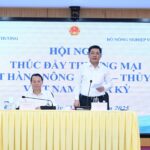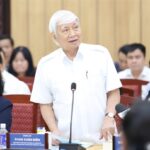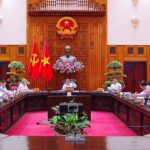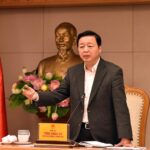
Prime Minister Pham Minh Chinh emphasized the unchanged goal of commencing the Lao Cai – Hanoi – Hai Phong railway project in 2025 and the high-speed North-South railway in 2026 – Photo: VGP/Nhat Bac |
On the morning of April 26, Prime Minister Pham Minh Chinh, Head of the Steering Committee for key national projects and programs in the railway sector, chaired the Committee’s second meeting. The conference was held in-person at the Government Office and connected with nine provinces and cities with railway projects.
Attending the conference were Central Committee members: Deputy Prime Minister Tran Hong Ha, Standing Deputy Head of the Steering Committee, Minister of Construction Tran Hong Minh, Minister of Science and Technology Nguyen Manh Hung, Minister of Education and Training Nguyen Kim Son, and Minister of Justice Nguyen Hai Ninh; leaders of central ministries and sectors and local leaders; and leaders of large economic groups.
Developing the railway industry and the railway industrial complex
Recently, the Central Committee, the Politburo, and the Government have actively considered proposals related to railway development, including upgrading existing railway lines, reconnecting previously interrupted lines, and implementing major railway projects such as the high-speed North-South railway, the line connecting with China, and urban railways in Hanoi and Ho Chi Minh City.
The National Assembly has issued Resolutions 172, 187, and 188 related to railway development, including: Resolution on investment policy for the high-speed North-South railway project; Resolution on investment policy for the Lao Cai – Hanoi – Hai Phong railway project; and Resolution on piloting special mechanisms and policies for developing the urban railway system in Hanoi and Ho Chi Minh City.
At the first meeting on March 29, 2025, the Prime Minister assigned 24 tasks to ministries, sectors, and localities, focusing on removing obstacles and accelerating investment procedures for the projects.
According to reports and opinions at the meeting, of the 19 tasks with deadlines, 12 are not yet due, 6 have been completed, and 1 is delayed, in addition to 5 regular tasks.
The Ministry of Construction has submitted to the Government a resolution to implement Resolution 172 of the National Assembly, which was approved by the Government in Resolution 106 on April 23, 2025. The Ministry has also submitted a draft resolution to implement Resolution 187 of the National Assembly, and the Government Office is collecting opinions from Government members.
The Ministry of Agriculture and Environment is developing a draft decree amending and supplementing Decree No. 156/2018/ND-CP, including regulations on temporary use and restoration of forests for the construction of temporary works serving the projects.
The Ministry of Science and Technology is formulating a decree on railway science and technology development and detailed regulations on research, application, and technology transfer.
The Ministry of Finance has completed procedures and reported to the Prime Minister for approval of the proposal for Line 3, the Hanoi Station – Yen So (Hoang Mai) section, as requested by the Hanoi People’s Committee. The Ministry has also provided guidance on discontinuing the use of ODA and preferential foreign loans for the Ho Chi Minh City urban railway project, Line 2, the Ben Thanh – Tham Luong section, and adjusting the capital source for the project.
The Ministry of Finance is directing and organizing the preparation of a proposal for the restructuring of the Vietnam Railway Corporation. The Ministry is also performing the task of establishing a State Appraisal Council in April 2025 to appraise the feasibility study report for the Lao Cai – Hanoi – Hai Phong project.
The Ministry of Education and Training is reviewing the planning of universities and colleges to ensure a sufficient supply of trained human resources for investment, management, operation, and development of the railway industry.
The Vietnam Railway Corporation is preparing a project for the railway industrial complex and has sent a document to the Ministry of Construction proposing special mechanisms to expedite the project’s progress. The Hanoi People’s Committee is studying and considering a decision within its authority to guide and complete the land handover procedures for the Corporation to build the industrial complex.
At the meeting, delegates reported on the implementation of projects, including the three railway lines of Lao Cai – Hanoi – Hai Phong, Hanoi – Lang Son, and Hai Phong – Mong Cai; the high-speed North-South railway; and urban railway projects in Hanoi and Ho Chi Minh City.

Leaders of ministries, sectors, and localities attend the meeting – Photo: VGP/Nhat Bac |
Unchanged deadline for the commencement of two major railway projects
Concluding the meeting, Prime Minister Pham Minh Chinh acknowledged the results achieved by ministries, sectors, and localities in performing their assigned tasks and commended proactive and active agencies and localities, including the Ministry of Construction, Hai Phong, Hanoi, and Ho Chi Minh City.
Highly appreciating the opinions expressed, the Prime Minister requested the Government Office, the Ministry of Construction, and relevant agencies to promptly incorporate them into the conclusion of the meeting.
With the spirit of the historic April days 50 years ago, when the South was liberated and the country was unified, the Prime Minister asked the members of the Steering Committee, ministries, sectors, and localities to act with “greater speed and boldness,” a strong sense of responsibility, clear assignment of tasks, authority, and timelines, and a forward-looking, innovative, and ambitious approach to implementing tasks quickly, decisively, and inspiringly.
The Prime Minister instructed ministries, sectors, and agencies to proactively and actively perform their functions, tasks, and powers in accordance with the Party’s guidelines, the State’s policies and laws, and the directions, conclusions, and instructions of the Central Committee, the Politburo, the National Assembly, the Government, and the Prime Minister.
Regarding overall tasks, the Prime Minister requested continued focus on synchronously implementing projects, including the high-speed North-South railway, the Lao Cai – Hanoi – Hai Phong line, and urban railways in Hanoi and Ho Chi Minh City. The spirit is to carry out both short-term and long-term tasks, including the development and completion of institutions, mechanisms, and policies and human resources training.
The Prime Minister emphasized the unchanged goal of commencing the Lao Cai – Hanoi – Hai Phong project in 2025 and the high-speed North-South railway in 2026.
Regarding capital sources, the Prime Minister directed the diversification of capital mobilization, including central and local self-balance, loans, government and corporate bond issuance, and public-private partnerships.
On legal issues, the Prime Minister assigned the Ministry of Construction and the Ministry of Justice to urgently complete a resolution unifying special mechanisms for all railway projects, submitting it to the Government in April and the National Assembly before May 5.
For the four government decrees, the Ministry of Construction will take the lead in developing a decree on overall technical design and special mechanisms and policies; a decree on criteria for selecting enterprises to provide services and goods; and a decree on railway science and technology development. The Ministry of Science and Technology will lead the development of a decree on railway science and technology development, and the Ministry of Agriculture and Environment will lead the development of a decree on temporary use and restoration of forests. The decrees are expected to be completed by May 2025.

Regarding capital sources, the Prime Minister directed the diversification of capital mobilization – Photo: VGP/Nhat Bac |
On developing the railway industry to serve the industrialization and modernization of the country, the Prime Minister emphasized the need to transfer and master modern technology, apply smart and scientific management, and train high-quality human resources. The Ministry of Construction and the Ministry of Education and Training should have short-term, medium-term, and long-term training plans for technical workers, engineers, and doctors.
The Ministry of Construction will take the lead in developing a decision by the Prime Minister on the list of railway industrial goods and services, to be completed by the first half of June 2025.
The Ministry of Industry and Trade will lead the development of a proposal for railway industry development, and the Ministry of Education and Training will lead the development of a proposal for human resources development. The two proposals are expected to be completed in the second quarter of 2025.
At the same time, it is necessary to mobilize the participation of state-owned and private corporations and enterprises with technological and production capabilities in railway projects and the development of the railway industry. The Ministry of Construction assigned corporations such as VNPT and Viettel to research, receive, develop, and master information, signaling, and control systems for railway projects.

The Prime Minister requested the mobilization of state-owned and private corporations and enterprises with technological and production capabilities – Photo: VGP/Nhat Bac |
Regarding the high-speed North-South railway project, the Government has approved the overall implementation plan, ensuring commencement by December 2026, according to Resolution 106/NQ-CP. The Prime Minister requested that ministries, sectors, and localities, based on the overall timeline and assigned tasks, formulate plans for their respective sectors and localities.
For the Lao Cai – Hanoi – Hai Phong project, agencies should continue to communicate and work with the Chinese side to expedite the completion of loan agreement negotiations, meeting the project’s progress requirements.
On site clearance for the projects, the Prime Minister stated that laws, mechanisms, and policies are already in place, and localities must take the initiative in site clearance, mobilizing the entire political system and forces; especially, site clearance for the Lao Cai – Hanoi – Hai Phong project should be completed by September this year.
Regarding urban railway projects in Hanoi and Ho Chi Minh City, the Prime Minister emphasized the spirit of decentralization and requested that localities apply the available special mechanisms and policies in their implementation. The Ministry of Construction and the Ministry of Agriculture and Environment will provide further guidance if difficulties arise.
The Prime Minister directed the People’s Committees of Hanoi and Ho Chi Minh City to urgently develop detailed plans and progress for implementing the mechanisms and policies of Resolution 188/2025/QH15 applicable to the two cities and issue plans within the local authority’s competence.
Ha Van
– 13:27 26/04/2025
“US-Vietnam Trade: Balancing the Equation with Agricultural and Aquatic Imports”
Amidst challenges in the export market, Vietnam proactively boosts agricultural imports from the United States to foster trade equilibrium and sustain the largest consumer market for its domestic agro-forestry-aquatic products.
The New Economic Frontier: Leading the Charge in Ho Chi Minh City’s Renaissance
Half a century has passed since the country’s reunification, and it has been a transformative journey for Ho Chi Minh City. The metropolis has always been vibrant and dynamic, witnessing and driving spectacular changes. Overcoming the challenges of the post-war era, the city has rapidly emerged as a major economic hub, solidifying its position as the nation’s leader.
The Swiss Report: Unveiling Vietnam’s Economic Potential
“With a population of over 100 million, Vietnam is an attractive prospect for foreign investors, and the country’s active diversification of its economy is paying dividends. So says the President of the Swiss-Asian Chamber of Commerce, highlighting the nation’s allure for international businesses.”
“A Streamlined Powerhouse: Ministry of Agriculture and Environment Merger Results in a Lean 30-Unit Structure”
The Ministry of Agriculture and Environment has undergone a significant restructuring, consolidating and organizing its units. With a total of 53 units previously belonging to two separate ministries – 26 from the Ministry of Environment and 27 from the Ministry of Agriculture and Rural Development – the new ministry has been streamlined into an efficient 30-unit structure.





















